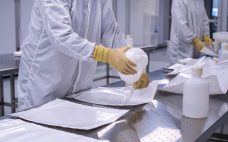This webcast features: Dr. Julia Baek, PhD, Staff Specialist, Ilaria Scarfone, PhD, MBA, Field Applications Specialist, and Chantelle Gaskin, Field Applications Specialist, Thermo Fisher The optimization of the downstream process for adeno-associated virus (AAV) production with consistent quality depends on the ability to characterize critical quality attributes affecting potency, purity, and safety of the final product. As the gene therapy field continues to push products through the clinical pipeline, an increasing need for efficient analytical tools has become evident. In…
Webinars
How to Optimize Final Filling in Bioprocessing
This webcast features: Andeka Ocio Velasco, Manufacturing & Process Validation Technician, Progenika Biopharma, a Grifols company; and Robert Martindale, Product Sales Manager, Masterflex EMEA, Antylia Scientific The final filling mistakes within bioprocessing are far too expensive to be allowed or tolerated. Continuous optimization is a commitment that all companies need to embrace to increase business profitability potential. Evaluating and utilizing new technologies will enable a faster methodology of process, increase the scaling up of bioprocesses, and increase the accuracy of…
Mixed-Mode Chromatography: Optimizing Target Purity and Recovery with Buffer Additives
This webcast features: Xuemei He, PhD, R&D Manager of Chromatography Media Chemistry, Bio-Rad Laboratories New biotherapeutic constructs continue to increase in biopharmaceutical development, extending treatment options to a broad range of diseases we face today. These biopharmaceuticals include recombinant proteins, monoclonal antibodies, antibody drug conjugates, bispecifics, viruses, and virus-like particles to mention a few. A simple, straightforward approach to the production of these biomolecules is required to meet the current demand for process efficiency and economics. Innovative chromatographic methods facilitate…
Inducible Secretion with ESETEC: The Solution for Difficult-to-Produce Proteins
This webcast features: Dr. Marcel Thoen, Head of Global Competence Center for Cell Line Development, Wacker Biotech Escherichia coli is the most popular expression system for all nonglycosylated biopharmaceuticals. However, common challenges include purification of expressed proteins recovered from the periplasm or those needing refolding from inclusion bodies. These constraints have been addressed by the unique secretion E. coli expression system ESETEC (E. coli secretion technology) developed by Wacker Biotech. Through years of experience, Wacker Biotech has observed that secretion…
Tools for Simplifying MSC Expansion, Cryopreservation, and DMSO Removal
This webcast features: Hilary Sherman, Senior Scientist, Corning Life Sciences Mesenchymal stem cells (MSCs) are one of the most frequently utilized cell types for cell therapy applications due to their ability to be isolated from several sources and easy adaptability to culture conditions. Bone marrow derived MSCs in particular are commonly studied due to their ease of access and achievable therapeutic dosage. While expanding MSCs to achieve these quantities, there is a risk for heterogeneity-induced quality failures during the manufacturing…
The Unique Benefits of Presterilized Fluoropolymer Bottles: Case Studies in Vaccine Delivery Applications
This webcast features: Eric Isberg, Vice President, Life Sciences, Savillex Fluoropolymers are the ultimate materials for use in bioprocess applications, providing increased purity, compatibility, inertness, and security for process fluids and bulk product. Bottles and vials manufactured from fluoropolymers have the added benefits of having virtually no leachables and extractables, a very wide service temperature range including performance down to liquid nitrogen temperatures, and unmatched durability, including being essentially unbreakable during use. This presentation will highlight the benefits of presterilized…
bioCERTIFIED: Turn Your Quality Management System into a Competitive Advantage
This webcast features: Jigisha Patel, VP of Regulatory Compliance & Technical Services, Spectrum Chemical Mfg. Corp. What can go wrong will go wrong—unless you eliminate unpredictability that results in reworks, rising costs, nonconformance, and unreliable product performance. Learn how to implement quality management systems throughout your entire supply chain and help accelerate biopharmaceutical development and production time for first-mover advantages. Whether it’s upstream or downstream processing, you will gain new insight that enables you to eliminate unpredictability and batch-to-batch variability…
Ensuring Viral Safety in Cell & Gene Therapy Through Next-Generation Sequencing
This webcast features: Horst Ruppach, Senior Scientific and Portfolio Director, Global Biologics, Charles River The viral contamination risk of cell and gene therapy products is significant. Multiple factors open the windows for viruses to enter the process. The current viral risk mitigation strategies have limitations and can either not be applied or have limitations to cover a broader range of potential viral contaminants. One of the most important entry points to monitor are the cells. They are used to produce…
Key Considerations for Maximizing LV and AAV Production in Transient Transfection Workflows
This webcast features: Leisha Kopp, Applications Scientist, Mirus Bio Recombinant adenoassociated virus (AAV) and lentivirus (LV) are critical components of gene and cell therapies, which show incredible promise for the treatment of disease. Accordingly, the need for large-scale manufacture of safe and effective viral vectors has never been greater. Here, we present: Optimization strategies for AAV and LV generation in both adherent and suspension HEK 293 cells LV and AAV enhancers that further increase functional virus titers over previously optimized…
“Breez”ing the Way into Process Development with Perfusion Technology
This webcast features: Kevin Lee, Co-Founder, Principal Scientist, Erbi Biosystems The priority of speed to market is often at odds with issues around development resources, facility space, and infrastructure for both development and manufacturing. Continuous bioprocessing provides solutions for many of these challenges in certain applications, but to deliver on this promise we need fit-for-purpose tools and technologies to enable process development and provide reliable transfer to commercial manufacturing. The migration to continuous processes in process development is further hindered…










